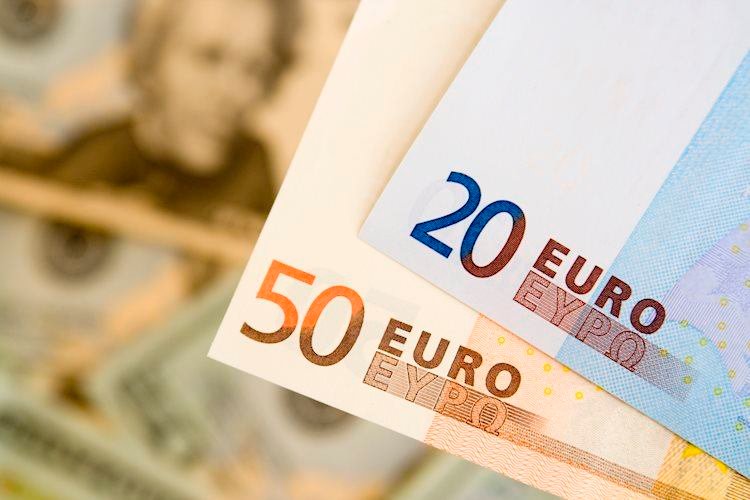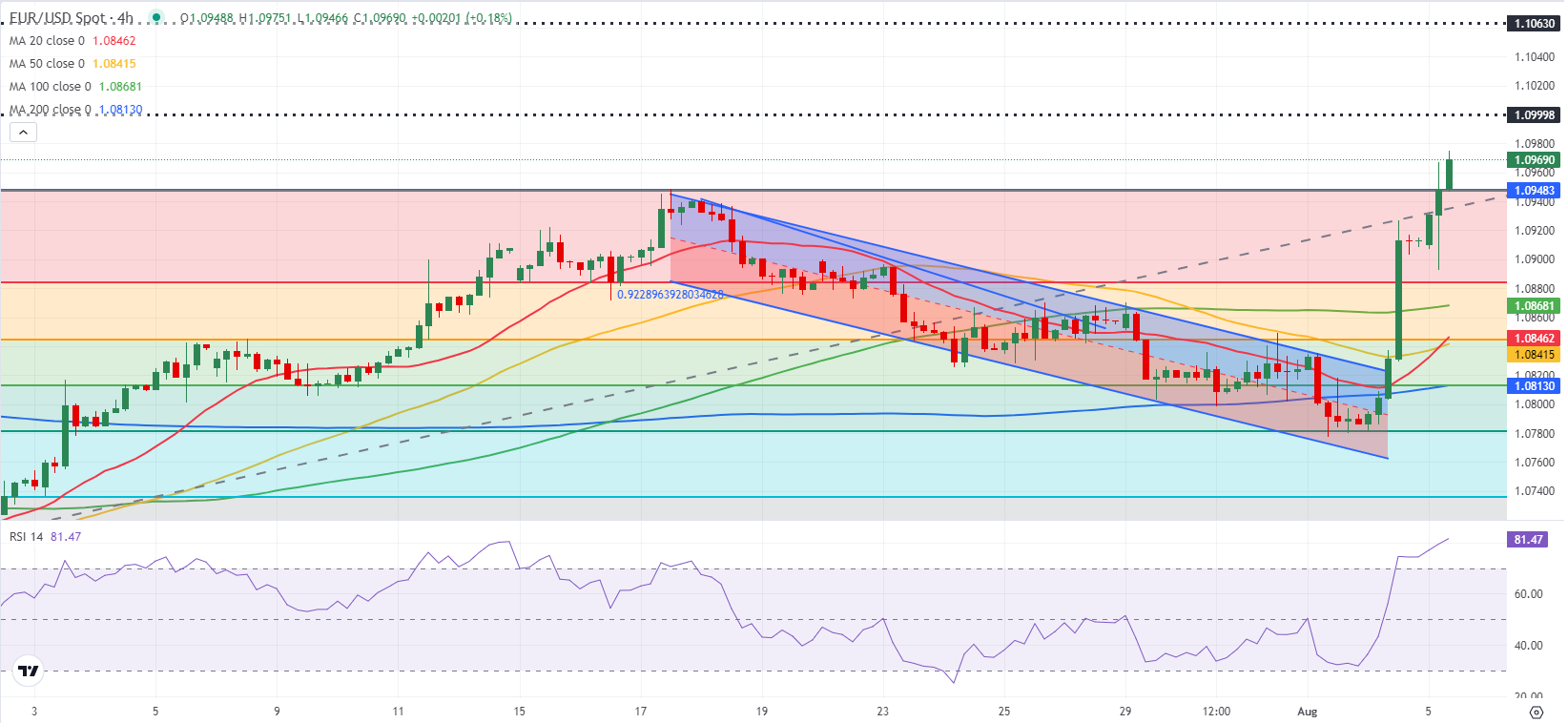- EUR/USD trades at its highest level since March above 1.0900 on Monday.
- The US Dollar stays under heavy selling pressure at the start of the week.
- The risk-averse market atmosphere could limit the pair’s upside.
After gaining more than 1% on Monday, EUR/USD extended its rally early Monday and reached its highest level since March near 1.0970. The pair’s near-term technical outlook points to overbought conditions.
Euro PRICE Last 7 days
The table below shows the percentage change of Euro (EUR) against listed major currencies last 7 days. Euro was the strongest against the Australian Dollar.
| USD | EUR | GBP | JPY | CAD | AUD | NZD | CHF | |
|---|---|---|---|---|---|---|---|---|
| USD | -1.01% | 0.54% | -7.07% | 0.26% | 1.43% | -0.58% | -3.76% | |
| EUR | 1.01% | 1.53% | -6.14% | 1.30% | 2.51% | 0.41% | -2.75% | |
| GBP | -0.54% | -1.53% | -7.59% | -0.24% | 0.98% | -1.08% | -4.22% | |
| JPY | 7.07% | 6.14% | 7.59% | 7.85% | 9.16% | 6.97% | 3.59% | |
| CAD | -0.26% | -1.30% | 0.24% | -7.85% | 1.20% | -0.87% | -3.98% | |
| AUD | -1.43% | -2.51% | -0.98% | -9.16% | -1.20% | -2.01% | -5.22% | |
| NZD | 0.58% | -0.41% | 1.08% | -6.97% | 0.87% | 2.01% | -3.17% | |
| CHF | 3.76% | 2.75% | 4.22% | -3.59% | 3.98% | 5.22% | 3.17% |
The heat map shows percentage changes of major currencies against each other. The base currency is picked from the left column, while the quote currency is picked from the top row. For example, if you pick the Euro from the left column and move along the horizontal line to the US Dollar, the percentage change displayed in the box will represent EUR (base)/USD (quote).
Disappointing labor market data from the US triggered an intense US Dollar (USD) selloff in the American session on Friday. Nonfarm Payrolls in the US rose 114,000 in July, missing the market expectation of 175,000 by a wide margin, and the Unemployment Rate climbed to 4.3% from 4.1% in June. Following the July jobs report, the CME FedWatch Tool shows that markets are nearly fully pricing in a 50 basis points Federal Reserve (Fed) rate cut in September.
Meanwhile, reports of Iran preparing to attack Israel in the next 24–48 hours force investors to seek refuge at the beginning of the week. Growing fears over a deepening conflict in the Middle East cause risk-sensitive assets to stay under selling pressure during the European trading hours. At the time of press, Euro Stoxx 50 was down 2.5% on the day and US stock index futures were losing between 1.5% and 3.8%.
In the American session, the ISM will release the Services PMI report for July. Investors expect the headline PMI to rise to 51 from 48.8. in June. A better-than-forecast print could ease concerns over an economic downturn in the US and help the USD stage a rebound with the immediate reaction.
Investors will keep a close eye on geopolitics in the second half of the day. Unless tensions in the Middle East ease, the market volatility could remain high in the near term.
EUR/USD Technical Analysis
The Relative Strength Index (RSI) indicator on the 4-hour chart rose above 80, reflecting overbought conditions for the pair. On the upside, 1.1000 (psychological level, static level) aligns as next resistance before 1.1060 (static level from May 2023) and 1.1100 (psychological level, static level).
1.0950 (static level, former resistance) could be seen as first support. If EUR/USD drops below that level and starts using it as resistance, it could extend its downward correction toward 1.0900 (psychological level, static level) and 1.0870 (100-period Simple Moving Average).
Euro FAQs
The Euro is the currency for the 20 European Union countries that belong to the Eurozone. It is the second most heavily traded currency in the world behind the US Dollar. In 2022, it accounted for 31% of all foreign exchange transactions, with an average daily turnover of over $2.2 trillion a day. EUR/USD is the most heavily traded currency pair in the world, accounting for an estimated 30% off all transactions, followed by EUR/JPY (4%), EUR/GBP (3%) and EUR/AUD (2%).
The European Central Bank (ECB) in Frankfurt, Germany, is the reserve bank for the Eurozone. The ECB sets interest rates and manages monetary policy. The ECB’s primary mandate is to maintain price stability, which means either controlling inflation or stimulating growth. Its primary tool is the raising or lowering of interest rates. Relatively high interest rates – or the expectation of higher rates – will usually benefit the Euro and vice versa. The ECB Governing Council makes monetary policy decisions at meetings held eight times a year. Decisions are made by heads of the Eurozone national banks and six permanent members, including the President of the ECB, Christine Lagarde.
Eurozone inflation data, measured by the Harmonized Index of Consumer Prices (HICP), is an important econometric for the Euro. If inflation rises more than expected, especially if above the ECB’s 2% target, it obliges the ECB to raise interest rates to bring it back under control. Relatively high interest rates compared to its counterparts will usually benefit the Euro, as it makes the region more attractive as a place for global investors to park their money.
Data releases gauge the health of the economy and can impact on the Euro. Indicators such as GDP, Manufacturing and Services PMIs, employment, and consumer sentiment surveys can all influence the direction of the single currency. A strong economy is good for the Euro. Not only does it attract more foreign investment but it may encourage the ECB to put up interest rates, which will directly strengthen the Euro. Otherwise, if economic data is weak, the Euro is likely to fall. Economic data for the four largest economies in the euro area (Germany, France, Italy and Spain) are especially significant, as they account for 75% of the Eurozone’s economy.
Another significant data release for the Euro is the Trade Balance. This indicator measures the difference between what a country earns from its exports and what it spends on imports over a given period. If a country produces highly sought after exports then its currency will gain in value purely from the extra demand created from foreign buyers seeking to purchase these goods. Therefore, a positive net Trade Balance strengthens a currency and vice versa for a negative balance.


